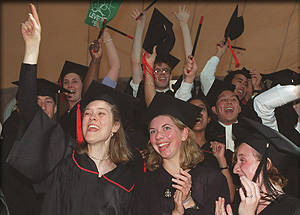
Students at Commencement. Courtesy of the Harvard University News Office.
The Education Oscars
U.S. 12th graders ranked 16th in science and 19th in math (out of 21 participating countries) on an international math and science test, reports the 2/25/98 Wall Street Journal. The test, part of the Third International Mathematics and Science Study (TIMSS), was administered in 1995 among high school seniors from countries such as France, Germany, South Africa, Cyprus, Slovenia, Iceland and the Netherlands. According to a commentary in the same issue of the Journal, East Asian countries, which ranked at the top in comparisons of lower grades, did not even join this study of high school students. The commentary also reveals that students from the U.S. qualified to take the advanced math and physics portions at a dismal rate, and then ranked next to last in advanced math and dead last in physics.The latest results prompted stern warnings about the prospects for education in the U.S. Edward B. Rust, Jr., the chairman of State Farm Insurance and the Business Roundtable’s education task force, warns in the same Journal article that if students are graduating without the “necessary skills,” jobs will “end up elsewhere.” John Leo, in the 3/7/98 U.S. News & World Report, attacks teacher education: “Largely because of the culture of teachers’ colleges, our public education is pervaded by social attitudes that work against achievement. One is the heavy emphasis on feelings, subjectivity, and self-esteem at the expense of actual learning and thinking.” Chester E. Finn Jr., a former assistant secretary of education commenting in the Journal, puts the blame squarely on public education’s systemic flaws: “The public school system as we know it has proved that it cannot fix itself. It is an ossified government monopoly that functions largely for the benefit of its employees and interest groups rather than that of children and taxpayers.”
First of all, is there a problem? Yes. Significant numbers of American students do poorly on pen-and-paper, short-answer math and science tests. Results from the TIMSS and other data suggest that our youngsters are not “measuring up” academically, notably in math and the sciences. The TIMSS data are notable because they provide the widest international comparisons of math and science achievement to date.
But there is a risk to reading too much into standardized tests such as the TIMMS. The TIMSS is a multiple-choice test. Over the past 20 years or so, many questions have arisen about the validity of short-answer tests as a measure of knowledge. Indisputably, they do measure test takers’ ability to review some large number of questions in a short time and for each question pick one “right” answer from among a handful offered. But the relation between that ability and knowledge is tenuous. Many experienced test takers can do well on a multiple-choice test without much preparation before or much retention after. They’ve developed a knack for taking such tests, which measure test-taking skills as much as, if not more than, “knowledge.”
Given a choice of doing well or doing badly on tests the obvious choice would be to do well. What I challenge is a disproportionate faith in short-answer tests. In fact, the ineffectiveness of short-answer tests in measuring knowledge has been widely accepted. For example, the Educational Testing Service has steered the SAT college entrance exam away from its short-answer format towards essays. Schools such as Harvard have stopped requiring SATs because of their poor validity and discriminatory biases. The problem is that better ways of assessing knowledge, such as essays, portfolios and “authentic assessment” (displaying or performing knowledge, such as producing a play or demonstrating a scientific procedure) and other more holistic approaches are much costlier and/or time-consuming to administer. There is resistance. In comparison, short-answer tests can be administered to large numbers in limited time slots, and graded electronically and quickly. So although they are more of an industrial mode of activity tied to Taylorist notions of productivity, short-answer tests survive.
Because of economics and resistance, such tests continue to decorate the gateways to “good” academic tracks and “good” jobs. So teachers teach them, parents ask for them and we study for them. It remains to be seen, though, whether all of this time and effort might be better spent elsewhere. According to the Los Angeles Times, an overwhelming number of Cal State’s incoming students lack the basic math and English skills they should have acquired in high school (cited in the 3/27/98 edition of Slate’s Today’s Papers). On the opposite coast, nearly 21,000 freshmen out of a total of about 200,000 students, or more than 10%, at the City University of New York (CUNY) are enrolled in remedial programs (New York Times, 3/31/98). These data might mean that students are developing or being taught test-taking skills at the expense of true learning. They might mean that standardized tests, such as the SAT, that purport to measure some kind of intangible potential for success in college do so poorly. Whatever they mean, they would indicate that our collective fervor over standardized tests is perhaps misplaced, and might be better directed at finding other ways to seek out and fix the problems apparent in our educational system.

Students at Commencement. Courtesy of the Harvard
University News Office.
The relation between the ability to do well on such tests and success in life is rather tenuous. Do you know any bosses at work whose academic performance as a youngster was so-so? Sure, we all know them. But that mediocrity in school tests didn’t keep them from success in the “real world.” Rust, quoted above on job loss, gives a quotable sound bite. But it’s a stretch to think that results on one multiple-choice test at one point in time should have the predictive power that he attributes to them. In fact, I’m curious about his high school scores.
Such test results mean little
in isolation. For example, most would acknowledge the engineering
wizardry of German industrialists and technological boldness of American
entrepreneurs. Both the U.S. and Germany are economic powers.
Yet, students from these two countries did average to poorly on the TIMSS.
Much else is at work in the U.S., for sure. Within limits, there
is a free market of ideas, a culture kind to entrepreneurialism, capital
to finance innovations, critical mass to establish markets and standards,
and mechanisms to discipline unresponsive or poor performers.
There is a clear need to develop
young people’s social consciousness and moral sensibility. One way
is to make community service a core part of all educational curricula.
Another is to model, recognize and reward altruistic behavior. Build
a caring society. Ralph Emerson told his audience at Harvard in the
1800s, “Character is higher than intellect.” Educational institutions
in many societies, including ours, originally developed as organized efforts
for moral cultivation. Modern education has turned this tradition
on its head. We limit our present-day discussions of education to
national curricula and standards. Such discussions, though, should
follow, not precede, how we envision society and imagine our next generations.
About the Author
Robert Eng is Vice President and Manager of E-Content for Group Employee
Services at Merrill Lynch. He is responsible for strategizing, producing,
and managing content for the company’s employee benefits web sites.
Previously, he was charged with developing and delivering educational programs
to corporate employees. Before joining Merrill Lynch in 1995, Mr.
Eng was a professor of education at Colgate University, and before that,
a corporate bond analyst at CS First Boston and Standard & Poor’s.
Mr. Eng has a bachelor’s degree from Brown University, an MBA from Columbia
and a doctorate from Harvard. He also received his Chartered Financial
Analyst (CFA) and Certified Financial Planner (CFP) designations.